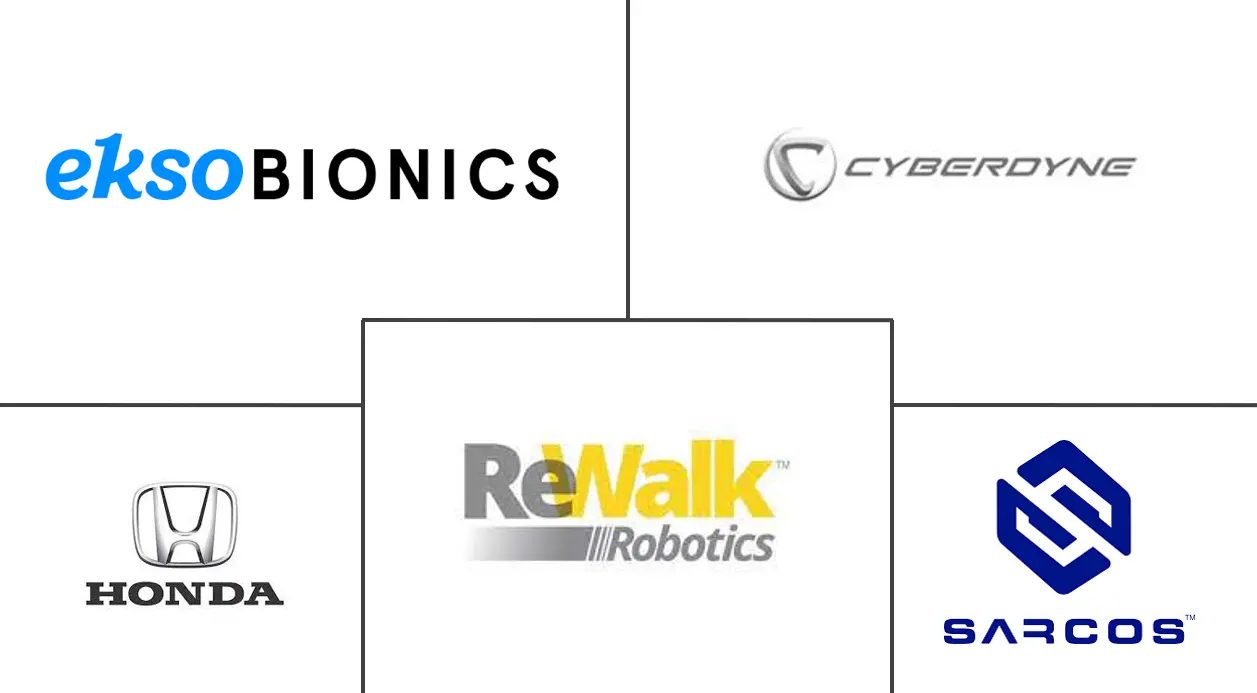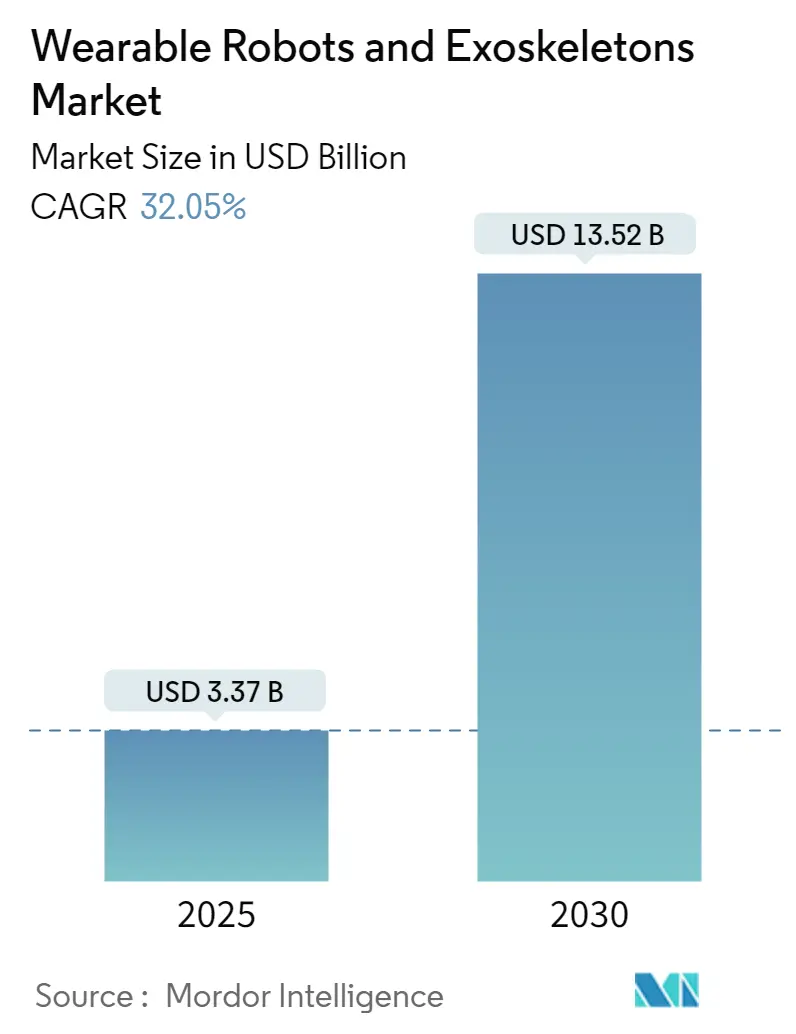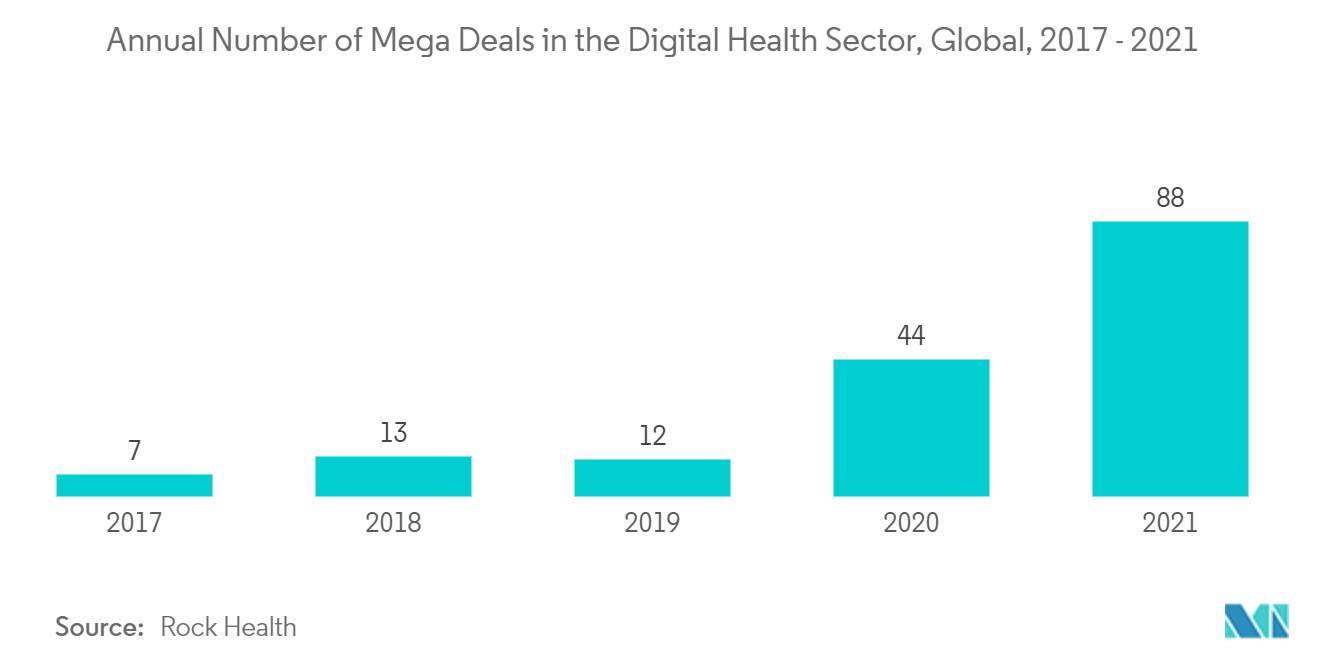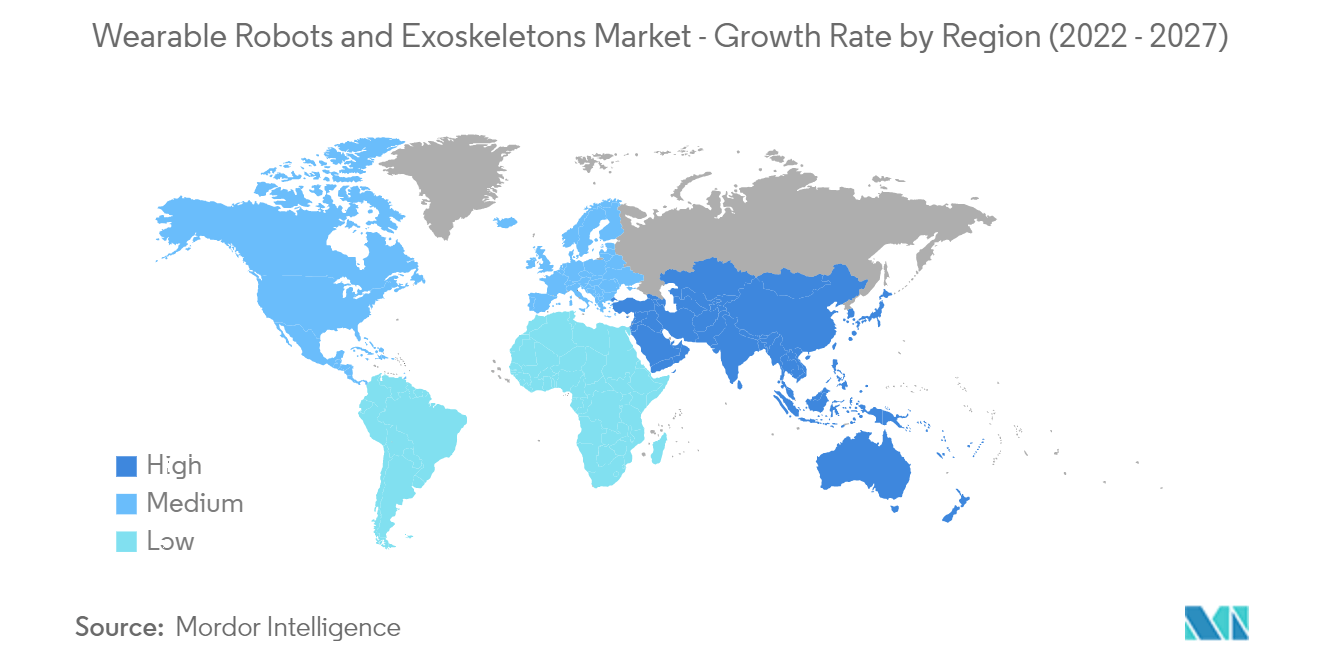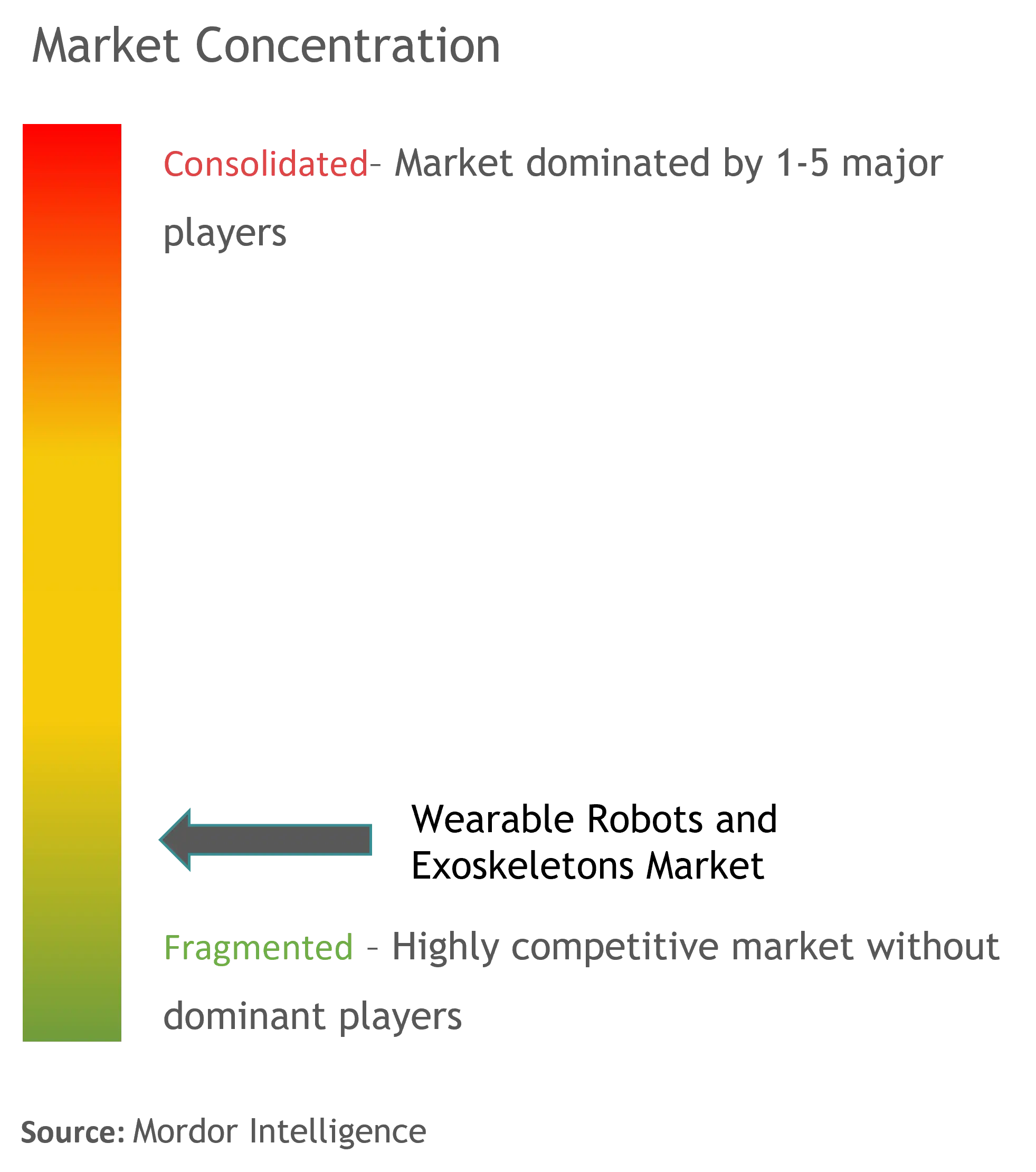Wearable Robots & Exoskeletons Market Analysis
The Wearable Robots and Exoskeletons Market size is estimated at USD 3.37 billion in 2025, and is expected to reach USD 13.52 billion by 2030, at a CAGR of 32.05% during the forecast period (2025-2030).
Due to the emergence of the COVID-19 pandemic, the previously put lockdown measures across various regions significantly brought the robotic suppliers to a complete standstill for a short period. However, on the other hand, the pandemic has also created productive industry opportunities for the products and service providers to increase their presence in the market by primarily focusing on and addressing real clinical challenges in collaboration with clinicians and industry partners and in response to the evolving patients' needs.
- The wearable robots or exoskeletons are in their nascent stage of development and continuously evolving to exhibit maximum adoption in various industries, like healthcare, industrial, military, and defense, as these wearable exoskeletons assist personal mobility and can be worn on the human body and control and assists the movements of the person.
- In the healthcare sector, exoskeletons are helping patients' recovery by assisting and encouraging upright walking and relearning lost functions for stroke patients and people who are paralyzed. According to a study by Maxon Motor AG, the company estimated that approximately 185 million people use a wheelchair daily worldwide.
- For instance, Ekso GT is an exoskeleton by Esko Bionics, which is a wearable exoskeleton engineered as a comprehensive gait therapy tool and provides an unparalleled rehabilitation experience for patients and therapists. Additionally, due to technological developments in technology, a paralyzed man started walking using a mind-controlled exoskeleton in France.
- Various companies in the industry have already tested exoskeletons for their manufacturing capabilities and are ready to deploy them, which is likely to augment the market in the future further. For instance, automobile manufacturer, Ford, planned to deploy exoskeletons in fifteen assembly plants worldwide and adopted the EksoVest. This exoskeleton elevates and supports the arms of workers performing repeated overhead tasks. The adoption of EksoVests reduced workplace injuries by 83% during the trial period.
- There is also an increasing demand for exoskeletons to assist in personal mobility. An increasing number of patients with body movement disorders, such as Parkinson's disease, strokes, etc., are the prime factors accelerating the exoskeleton demand, as these diseases limit voluntary body movements and create problems in daily routine activities. For instance, according to the Parkinson's Foundation estimates, the number of people in the United States with Parkinson's disease may be around 930,000 in 2020, and it is expected to reach 1,200,000 by 2030.
Wearable Robots & Exoskeletons Market Trends
Healthcare is Expected to Hold a Significant Share
- Exoskeletons have increasing applications in medical industries ranging from physiotherapy to emergency services. For example, GenElek Technologies, a Delhi-based startup, provides a robotic support system that aids people suffering from stroke, paralysis, spinal cord injury (SCI), or other neurological conditions. The exoskeleton assists disabled people in walking again. It will help them become self-reliant and independent, which will benefit them physically and mentally. These advancements mentioned above are expected to drive the healthcare market.
- According to a report of the Rehabilitation Council of India, every year, more than 15,000 people lose their ability to walk either due to a spinal injury or stroke in India, which translates to 15 new cases per million every year, which provides an opportunity for local companies to provide an externally worn robotic and exoskeleton support system that enhances a human's limbic capabilities.
- Further, many players in the market are constantly trying to innovate products for people in the Healthcare industry and get the necessary approval. For instance, ReWalk Robotics, a manufacturer of robotic medical devices for individuals with lower limb disabilities, announced that the US Food and Drug Administration had cleared its ReStore soft exo-suit system for sale to rehabilitation centers across the United States.
- Moreover, some smaller companies have also emerged. For instance, Japan-based Archelis Inc. showcased the ArchelisFX exoskeleton, which derives from the Japanese word for "walkable chair." The device is designed for several scenarios, including back pain and recently undergoing surgery. The company said it would be available to rent or buy for around USD 5,000.
- In January 2021, suitX, a California-based innovator in exoskeleton technologies, announced the launch of a novel wearable exoskeleton, shieldX. It is made for the healthcare personnel required to wear heavy anti-radiation aprons. ShieldX removes 100% of the weight of a heavy anti-radiation apron from the user's shoulders and spine. ShieldX aims to reduce neck and back injuries linked to these heavy aprons shortening careers and limiting activities outside of work.
Asia Pacific is Expected to Account for the Largest Market Share
- Asia-Pacific is the leader in the R&D of wearable robot technology. South Korea and Japan are specifically leading in the R&D of the market. For instance, in April 2021, a South Korean research team from the Korea Institute of Machinery and Materials developed a wearable robot technology, a suit-type wearable device, that can be used for a variety of physical tasks from delivery to construction work. It can be attached to the arm, thigh, and other body areas for supporting muscles.
- South Korea has always been the hub for the manufacture of robotics and automation technologies. The focus on R&D and government expenditure on innovative technologies were significant factors for the advancement of wearable robotics in the country. The private sector of the country is also actively expanding its technologies and applications range related to wearable robots and exoskeletons.
- For instance, in June 2021, Samsung Electronics Co. announced to commercialize of a wearable robot for healthcare by the end of 2021. This South Korean tech giant is delving into the robotics sector as one of its major growth drivers. According to the company, it has plans to introduce a wearable robot that helps users that have trouble standing up, walking, or running and can also be used as a fitness device. This wearable robot is expected to be priced between KRW 5 million and KRW 10 million, but the company may bring the price down to make it more affordable.
- Wearable robots and exoskeleton market players are increasingly investing in the Asia-Pacific region. For instance, in April 2021, Ekso Bionics, an industry leader in the exoskeleton market with a presence in Hong Kong, announced a partnership with Royal Rehab in Australia, further expanding the use of the company's robotic exoskeleton across Asia-Pacific.
- Militaries in the region are also developing exoskeleton robots for their troops. For instance, in October 2021, Taiwan launched the first generation of a battery-powered exoskeleton suit that can improve the physical endurance of soldiers and increase mobility in various military operations.
Wearable Robots & Exoskeletons Industry Overview
The Wearable Robots and Exoskeletons Market is competitive in nature because of the presence of major players like Cyberdyne Inc., ReWalk Robotics Inc., and Ekso Bionics Holdings Inc., among others. Further, the market potential is also attracting many startups investing in the market, thus, intensifying the competition. Many companies increase their market presence by introducing new products, expanding their operations, or entering into strategic mergers and acquisitions.
- July 2021 - Cyberdyne Inc has formed a business alliance with J-Workout Inc. (Koto-Ku, Tokyo, Japan, President: Takunori Isa, "J-Workout") to provide a new service stated below from August 2021. The Group provides Neuro HALFIT as a service to promote the functional improvement of people with reduced motor functions by activating the activity loop of the brain's nervous system with Wearable Cyborg HAL.
- March 2021 - Ekso Bionics announced a partnership with the US Physiatry to educate physicians on the clinical benefits of an EksoNR exoskeleton. The partnership will help raise awareness of Ekso Bionics technology among physicians and other rehabilitation therapists and teach them how to integrate robotics into rehabilitation programs successfully.
Wearable Robots & Exoskeletons Market Leaders
-
Cyberdyne Inc.
-
ReWalk Robotics Inc.
-
Ekso Bionics Holdings Inc.
-
Sarcos Corporation
-
Honda Motor Co. Ltd
- *Disclaimer: Major Players sorted in no particular order
Wearable Robots & Exoskeletons Market News
- November 2021 - Rewalk Robotics Ltd received a 'Breakthrough Designation' from the FDA for its ReBoot, battery-powered orthotic exo-suit, designed to assist ambulatory functions in individuals with reduced ankle function related to neurological injuries, such as stroke. It is intended for home and community use.
- March 2021 - DIH International Limited, the parent company of Hocomo, partnered with Reha technology to distribute the rehabilitation robotics products developed by the latter in Switzerland, Germany, and the United States. The products are end-effector-based gait therapy devices for lower extremities rehabilitation.
Wearable Robots & Exoskeletons Industry Segmentation
The study categorizes the type of exoskeletons as powered exoskeletons and passive exoskeletons. The study also categorizes the use of wearable exoskeletons in various end-user segments, such as healthcare, military and defense, and industrial, among others. The market studied is tracked based on the revenue accrued by vendors operating in the market, received from the sales/rental of the exoskeleton and wearable robots used to enhance the performance of users. Prosthetics are not considered under the scope of the study. Further, the report also covers the analysis of the COVID-19 impact on the market and stakeholders, and the same has been considered for the current market estimation and future projections.
| By Type | Powered Exoskeletons |
| Passive Exoskeletons | |
| By End-user Industry | Healthcare |
| Military and Defense | |
| Industrial | |
| Other End-user Industries | |
| By Geography | North America |
| Europe | |
| Asia Pacific | |
| Rest of the World |
Wearable Robots & Exoskeletons Market Research FAQs
How big is the Wearable Robots and Exoskeletons Market?
The Wearable Robots and Exoskeletons Market size is expected to reach USD 3.37 billion in 2025 and grow at a CAGR of 32.05% to reach USD 13.52 billion by 2030.
What is the current Wearable Robots and Exoskeletons Market size?
In 2025, the Wearable Robots and Exoskeletons Market size is expected to reach USD 3.37 billion.
Who are the key players in Wearable Robots and Exoskeletons Market?
Cyberdyne Inc., ReWalk Robotics Inc., Ekso Bionics Holdings Inc., Sarcos Corporation and Honda Motor Co. Ltd are the major companies operating in the Wearable Robots and Exoskeletons Market.
Which is the fastest growing region in Wearable Robots and Exoskeletons Market?
Asia Pacific is estimated to grow at the highest CAGR over the forecast period (2025-2030).
Which region has the biggest share in Wearable Robots and Exoskeletons Market?
In 2025, the North America accounts for the largest market share in Wearable Robots and Exoskeletons Market.
What years does this Wearable Robots and Exoskeletons Market cover, and what was the market size in 2024?
In 2024, the Wearable Robots and Exoskeletons Market size was estimated at USD 2.29 billion. The report covers the Wearable Robots and Exoskeletons Market historical market size for years: 2019, 2020, 2021, 2022, 2023 and 2024. The report also forecasts the Wearable Robots and Exoskeletons Market size for years: 2025, 2026, 2027, 2028, 2029 and 2030.
Our Best Selling Reports
Wearable Robots & Exoskeletons Industry Report
Statistics for the 2025 Wearable Robots and Exoskeletons market share, size and revenue growth rate, created by Mordor Intelligence™ Industry Reports. Wearable Robots and Exoskeletons analysis includes a market forecast outlook for 2025 to 2030 and historical overview. Get a sample of this industry analysis as a free report PDF download.

